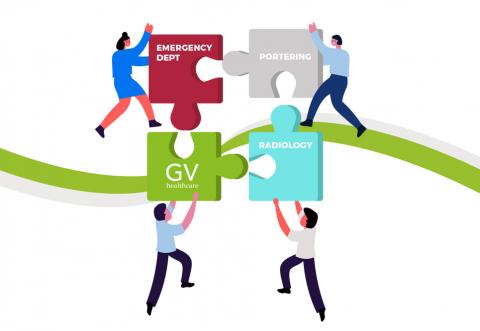Recent insights from a BBC report underscore the pressing need to rethink our strategies for patient discharge. It is evident that a substantial number of hospital beds, around 12,000 per day in England, are occupied by patients awaiting discharge. While some await transfer to care homes, at the mercy of their own bed availability, others face challenges in areas like patient transport, medication distribution, and paperwork processing, leading to unnecessary delays in their discharge.
In response, GV Healthcare, known for pioneering solutions that have an impact on improving patient movement in areas not stereotypically at the forefront of people’s minds when it comes to patient flow, have undertaken a data-driven exploration to look into new ways a patients journey can be improved through insights into their movements throughout the hospital, with a focus on uncommon pathways to optimise movement, aiming to minimise bottlenecks and enhance overall efficiency.
The Health Foundation, a beacon of positive change in the UK healthcare landscape, published a study a year ago projecting the need for 23-39,000 additional beds by 2030/31. This forecast reflects an aging and increasingly complex patient demographic. The issue at hand eclipses mere bed availability; it calls for innovative interventions to improve discharge factors.
Among the multifaceted solutions proposed by The Health Foundation are:
1. Increase Hospital Bed Supply (i.e. more beds with more staff – as in the example above)
2. Do Things Faster (i.e. Speed things up, reducing a patient’s time in hospital – improve patient flow)
3. Do Things Differently (i.e. New ideas, like virtual wards and other digital solutions)
4. Do Less (i.e. By better meeting patient needs)
We must critically evaluate patient flow and tackle these reasons for discharge bottlenecks head-on. While a recent decision to allocate £700 million for additional care packages and beds offers relief, it's evident that more all-encompassing strategies are essential. Simply accommodating more patients won't resolve the core issue. Thousands of people who don’t need to be in hospital, will still be there, still needing care at a cost to the hospital when they ideally should have been discharged instead. Improvements like more beds help in isolation, but do not solve the problem. It's time to think differently and reimagine patient flow from a non-clinical perspective.
Charting a Fresh Course for Streamlined Discharges
Data mirrors patient movement, it flows when patients do, and GV Healthcare’s data-driven endeavours reveal that Soft FM (Facilities Management) plays a pivotal role in enhancing patient flow. Elevating porter efficiency translates to accelerated patient movement within the hospital, facilitating prompt appointments and discharges, freeing up bed space for new patients. Notably, areas like Emergency Departments (ED) and Radiology, frequently congested due to patient influx, benefit significantly from optimised porter operations.

Thinking differently about the impact Soft FM can have in ED has resulted in success at Hull Royal Infirmary and their story illustrates the power of innovation, one which can be seen in a case study with the Trust. By modernising porter practices, they reduced task times in the ED by a minute and a half per task. This transformation nurtured enhanced collaboration between departments, fostering smoother patient transitions. Helen Ingleson, Senior Matron within Hull Royal Infirmary ED, attested to the tangible benefits: “We’ve seen such a massive improvement; from jobs that have been requested, we can keep an audit trail and we always know where the porters are, where they are on the job. (It also means) time spent with patients instead of chasing about looking after them (nurses no longer doing porter tasks)”. Dave Houghton, Interim Portering Postal & Switchboard Manager, added “It has enabled us to allocate porters to the right area quicker. It has also increased patient flow because now we have the right porter, in the right place, at the right time”.
Sunderland Royal Hospital's journey mirrors this triumph. Their portering enhancements drove a remarkable 28% increase in overall throughput within a year of implementation. The impact is profound - swifter scans, speedier care pathways, and freed-up beds for new admissions. Juliet Bwanya, Senior Radiographer, said “We don’t have patients lining up in the corridor and once we’ve finished, a Porter is already alerted that somebody needs to go back”.
Pioneering Patient Flow Through Data-Driven Insights
Harnessing visible data fosters collaborative communication along the care pathway. It empowers Facilities Management and Patient Flow specialists to orchestrate tasks not just in portering, but also with cleaning tasks and bed management visibility, seamlessly. This holistic approach translates into better working collaboration, swifter bed turnaround times, improved patient outcomes, and efficient resource utilisation – the visibility the data gives allows both the teams and the patients what they need, when they need it. By doing things differently, it allows us to do things faster.
In essence, innovative thinking merges solutions 2 and 3 proposed by The Health Foundation. A cohesive patient journey hinges on interconnected strategies across multiple departments – data and visibility of that data are key to this success. Each department brings a different piece of the puzzle that is patient flow, and it’s not until they work together to connect the pieces that we’re able to see the bigger picture. Are you prepared to reimagine patient flow and champion expedited discharges by thinking differently?
For a deeper dive into how prioritising patient flow with non-clinical teams can be the catalyst to enhancing patient discharge rates, please contact us via email at: [email protected]
Image credit: iStock



















